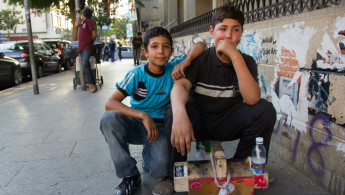The plight of Lebanon's working street children
Thousands of children, including many Syrian refugees, are living and working in desperate conditions across Lebanon.
4 min read
File Photo: Most street-based children are between the ages of seven and 14 [Tabitha Ross/ILO]
A total of 1,510 children are living or working on the streets of Lebanon, a new study has revealed, shedding light on the increasingly visible phenomenon of one of the worst forms of child labour.
Lebanon adopted a national action plan during the Global Child Labour Conference at The Hague in 2010, pledging to eliminate child labour by 2016.
However, despite the government's continuous efforts to combat the issue, the number of children living on the street continues to rise.
Lebanon adopted a national action plan during the Global Child Labour Conference at The Hague in 2010, pledging to eliminate child labour by 2016.
However, despite the government's continuous efforts to combat the issue, the number of children living on the street continues to rise.
"The prevalence of children living or working in the streets is a long-standing issue that poses a persistent challenge and straddles larger socioeconomic issues in Lebanon," said Ian Rodgers, Save the Children International's Lebanon representative.
Social exclusion, vulnerability of households, organised crime and exploitation of children were identified as the main factors causing children to live or work on the streets of Lebanon.
However, the influx of Syrian refugees has also heavily contributed to the prevalence of children's plight, with 73 percent of street-based children coming from Syria.
Fadi is an eight-year-old Syrian boy who was brought to Lebanon by his uncle and then left to fend for himself on the streets.
The age of children such as Fadi is the most concerning matter, with children as young as five found to be begging.
"Children on the streets are extremely vulnerable to all forms of exploitation and abuse in their daily lives, as well as occupational hazards," said Unicef's Lebanon representative, Annamaria Laurini.
Ten-year-old Manal is no stranger to this abuse. Leaving school early to help her parents support her seven sisters and four brothers, the young Lebanese is exposed to physical and emotional abuse on a daily basis.
Street work
Most street-based children enter the work market between the ages of seven and 14.
Their workdays can vary considerably from four to 16 hours per day, on an average of at least six days per week, earning less than $12 a day.
The most common type of work among these children is begging and street vending, but some have been exposed to more extreme illicit activities such as drug dealing, gang activity and prostitution.
 |
Some children have been exposed to more illicit activities such as drug dealing, gang activity and prostitution |  |
A 12-year-old Palestinian from Ayn al-Hilweh, the largest Palestinian refugee camp in Lebanon, who was forced to work for his drug-dealing father, was caught, imprisoned and now lives in an institution.
Another child from Nabatieh in southern Lebanon was also imprisoned for stealing after joining a gang.
Around 29 percent of street-based children say they have been chased or arrested by law enforcement officials, however the study found that non-Lebanese children were more likely to be arrested than their Lebanese counterparts, with Syrians and Palestinian refugees counting for the highest share.
Vulnerable situations
Some street children have suffered from domestic violence in the home, such as Rami, a 12-year-old Syrian street worker, who came to Lebanon after running away from his abusive father.
Many children have also been victims to rape and sexual assault.
However, almost half of them believe they have no one to report these abuses to.
"Creating a protective environment, where laws, services, and practices minimise children’s vulnerability is a priority for Unicef," Laurini added.
 |
Many children have also been victims to rape and sexual assault |  |
A majority of the street-based children from the study were found to be either illiterate and many had never attended formal education.
When asked about their aspirations, most wanted to be at school.
The report also found that a large number of these children had high career aspirations, mainly ones that required a degree - including engineering, medicine and teaching.
"We are committed to the Convention on the Rights of the Child, especially the right of children to education and protection from work that harm them," Rodgers said. "We will make all concerted efforts with the government and relevant civil society to withdraw children from the streets."
Although the organisations believe the numbers are on a manageable scale, the issue is a highly complex.
"From dealing with hazardous weather, to traffic accidents to being lured into illicit activities, these children are facing all sorts of dangers," said Hayat Osseiran, the ILO's child labour specialist.
"We are now seriously looking into the best way to tackle the issue along with the government and NGOs. Our aim is to find a long-term resolution to get these children off the streets using a comprehensive manner."
Osseiran said that by working alongside NGOs and giving staff the training needed in working with children, they aim to find temporary shelter for these youngsters and their families until they are referred to appropriate rehabilitation centres.
"Each child has come from a different background and situation, therefore special attention is required in dealing with each case in order to provide the best long-term solution," Osseiran added.





 Follow the Middle East's top stories in English at The New Arab on Google News
Follow the Middle East's top stories in English at The New Arab on Google News


